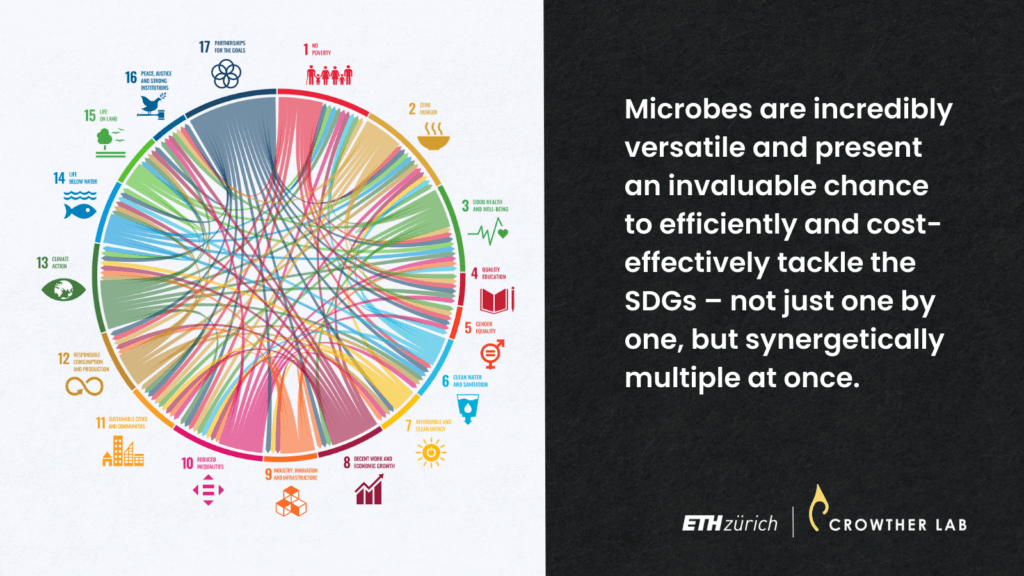From deep ocean trenches to the human gut: microbial organisms are ubiquitous, highly diverse and essential to sustaining life on Earth. Their high relevance, however, is not reflected in action plans about how to reach the UN Sustainable Development Goals. Scientists now demonstrate in which ways microbe-based technologies can synergistically help achieve our “Global Goals”.
Across the world, much effort – from small, local projects to multilateral treaties – has been put into reaching the UN Sustainable Development Goals (SDGs). Yet until now, plans for achieving these goals have overlooked one critical component: microbial organisms. A new study from Crowther Lab at ETH Zurich shows that microbial innovations have immense potential to tackle multiple SDGs at once and contribute to a more sustainable future.
Microbes: the tiny, but powerful engineers of planetary life
It is one of the most significant events in our planet’s history: the emergence of microorganisms – bacteria, archaea, viruses, fungi, and protists – three billion years ago. This development not just enabled all other life forms to exist, microbes also keep planetary life running to this day. All across the world, these powerful organisms contribute to the functioning of the planetary system by processing key nutrients and gasses for our survival – deep in the ocean, buried in our soils, or in our human guts. Together they represent a wealth of biodiversity and an estimated 99% of all species on Earth.
Given how indispensable microbial activity has been for our planet’s past and present, it seems unimaginable to think of a future without the world’s microbes. But where are they in discussions about shaping a more sustainable world?
From clean energy to recycling: the world of microbial innovations
The UN Sustainable Development Goals are a global framework developed to tackle the myriad of ongoing challenges we are facing and guide us towards a sustainable future by 2030, covering seventeen issues from poverty to education, from clean energy to sustainable cities and climate action. Much effort has already been spent to develop tools and policies to achieve the SDGs but mentions of the life-sustaining processes bacteria, fungi and other microorganisms maintain are few and far between.
A new paper in Cell led by the Crowther Lab at ETH Zurich now offers a first-time overview of the myriad of ways microbes can help to achieve the SDGs. The authors identified seven key areas where microbial technologies can strengthen sustainable practices: disease prevention, nutrition and food production, clean energy, recycling, bioremediation, ecosystem restoration and maintaining global biogeochemical cycles.
“Microbial technologies can be used to tackle the SDGs in incredibly versatile ways”, shares lead author Laura van Galen, a postdoctoral researcher in the Crowther Lab. “We use microbes to produce vaccines and pharmaceuticals to improve human health and reduce poverty and inequality. But they can also be used to boost food production – as mycoprotein they are in fact a food source themselves – and reduce our use of pesticides and fertilisers. Microbial communities contain huge potential to speed up plant growth and facilitate ecosystem restoration, and can help with providing clean energy through biofuels, thus mitigating climate change.”

Technologies integrating microbes are indispensable to reaching the UN Sustainable Development Goals.
Harnessing synergies to tackle the UN Sustainable Development Goals
These examples show that the diverse areas microbes can be applied to tackle issues such as food insecurity, climate change, or pandemics, are actively researched – yet usually in isolation from one another. The new study, however, raises critical awareness for how microbes can tackle the SDGs synergistically.
Take the example of bioremediation: using bacteria, archaea, fungi, or microalgae to remove contaminants from the environment will not only directly improve life on land and in the water (SDGs 14 and 15), clean water availability (SDG 6) and human health through disease prevention (SDG 3), but will help efforts to reach up to nine other SDGs as well. Flow-on benefits from microbial bioremediation will also positively impact key SDGs related to reducing inequalities, providing safe food, and sustainably managing waste.
Even SDGs that might not appear to be directly related to microbes – such as gender equality (SDG 5) or peace, justice and strong institutions (SDG 16) – are still indirectly influenced by them. “To reach these goals we need things like better healthcare targeted at women and minority groups, and more equitable food production and distribution. Though we still have a long way to go before their full potential can be scaled-up and used in real-world situations, microbial technologies can go a long way in helping us achieve these things,” remarks van Galen.
The fact that microbial processes are fundamental to achieving the SDGs may seem trivial, but given the urgency and pressure to facilitate a more sustainable future, harnessing the world’s microbes presents an efficient, cost-effective opportunity to tackle various sustainability agendas at once.
Reference
Crowther TW, Rappuoli R, van Galen LG, et al.: Scientists’ Call to Action: Microbes, Planetary Health, and the Sustainable Development Goals. Cell, 19 September 2024, doi:10.1016/j.cell.2024.07.051


